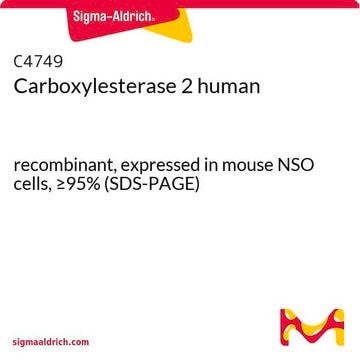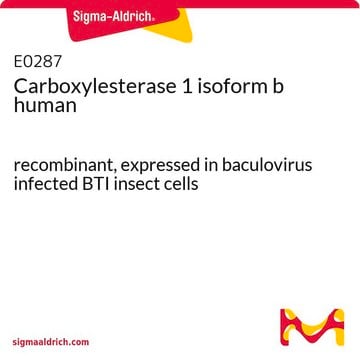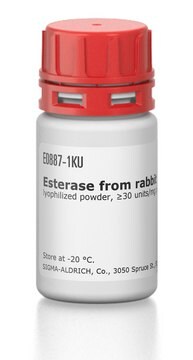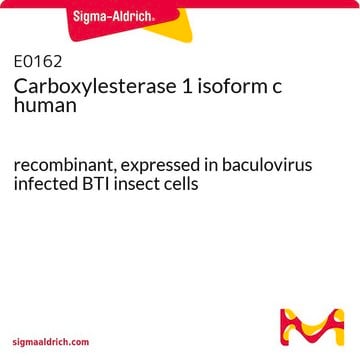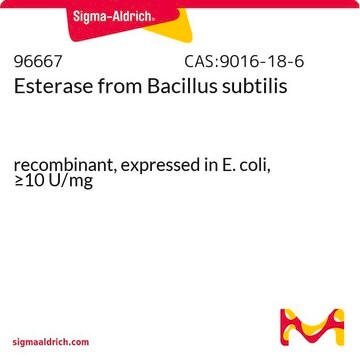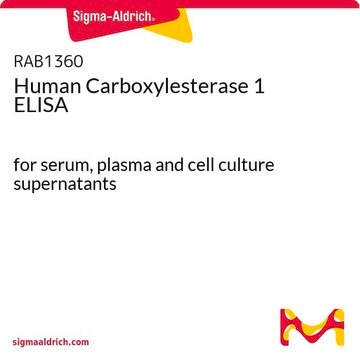E0412
Carboxylesterase 2 human
recombinant, expressed in baculovirus infected BTI insect cells
Synonym(s):
Carboxylesterase 2 human, CES2, CES2A1
Sign Into View Organizational & Contract Pricing
All Photos(1)
About This Item
Recommended Products
recombinant
expressed in baculovirus infected BTI insect cells
Quality Level
form
liquid
specific activity
≥500 units/mg protein
mol wt
60 kDa
weight
(0.5 ml)
shipped in
dry ice
storage temp.
−70°C
Looking for similar products? Visit Product Comparison Guide
General description
Carboxylesterase 2 human gene is mapped to human chromosome 16q22.1.
Carboxylesterase belongs to the α/β hydrolase fold family and is involved in drug metabolism and activation. It is present in colon, liver, small intestine, heart, brain and testis. The hydrolase activity of small intestine is attributed to carboxylesterase 2 human. It has two glycosylation sites at 103 and 267 residues with molecular mass 60kDa.
Application
Carboxylesterase 2 human has been used:
- in the in vitro enzyme-based inhibitor screening assay
- in substrate selectivity assay with emission ratiometric two-photon probe (SE1)
- as a reference standard in the enzyme assay with various 4-nitrophenyl and 1-naphthyl based substrates
Carboxylesterase 2 may play a key role in biotransformation of a variety of ester containing drugs and prodrugs.
Delivers high catalytic activity, ideal for robust high-throughput screening assays including drug-drug interaction studies, and pharmacokinetic studies for evaluating pro-drugs and non-CYP pathways of elimination.
Biochem/physiol Actions
Carboxylesterase 2 human identifies the site containing a large alcohol and small acyl group. It shows less transesterification activity due to presence of conformational interference in active site.
Member of a serine esterase family that hydrolyze ester and amide bonds. Carboxylesterase 2 is an endoplasmic reticulum-bound hydrolase that plays a critical role in xenobiotic detoxification and activation for ester-containing therapeutics. Carboxylesterase 2 is also involved in the detoxification of drugs such as heroin and cocaine. This enzyme is thought to play a role in lipid metabolism.
Unit Definition
One unit will produce 1 nanomole of 4-nitrophenol from 4-nitrophenyl acetate per minute at pH 7.4 at 37 deg C.
Storage Class Code
10 - Combustible liquids
WGK
nwg
Flash Point(F)
Not applicable
Flash Point(C)
Not applicable
Certificates of Analysis (COA)
Search for Certificates of Analysis (COA) by entering the products Lot/Batch Number. Lot and Batch Numbers can be found on a product’s label following the words ‘Lot’ or ‘Batch’.
Already Own This Product?
Find documentation for the products that you have recently purchased in the Document Library.
Customers Also Viewed
T Satoh et al.
Annual review of pharmacology and toxicology, 38, 257-288 (1998-05-23)
Multiple carboxylesterases (EC 3.1.1.1) play an important role in the hydrolytic biotransformation of a vast number of structurally diverse drugs. These enzymes are major determinants of the pharmacokinetic behavior of most therapeutic agents containing ester or amide bonds. Carboxylesterase activity
Sang Jun Park et al.
Chemical science, 7(6), 3703-3709 (2016-06-01)
Carboxylesterases (CEs) are widely distributed enzymes in the human body that catalyze hydrolysis of various endogenous and exogenous substrates. They are directly linked to hepatic drug metabolisms and steatosis, and their regulations are important issues in pharmacological and clinical applications.
Yaping Yu et al.
Oncotarget, 9(46), 27958-27973 (2018-07-03)
Chemotherapy-induced diarrhea (CID), with clinical high incidence, adversely affects the efficacy of cancer treatment and patients' quality of life. Our study demonstrates that the citrus flavonoid hesperetin (Hst) has a superior potential as a new agent to prevent and alleviate
S Omedes et al.
Environmental research, 210, 112961-112961 (2022-02-20)
Cephalopods are a group of marine invertebrates that have received little attention as sentinel species in comparison to other molluscs, such as bivalves. Consequently, their physiological and biochemical xenobiotic metabolism responses are poorly understood. Here we undertake a comparative analysis
Teruko Imai
Drug metabolism and pharmacokinetics, 21(3), 173-185 (2006-07-22)
Human carboxylesterase 1 (hCE-1, CES1A1, HU1) and carboxylesterase 2 (hCE-2, hiCE, HU3) are a serine esterase involved in both drug metabolism and activation. Although both hCE-1 and hCE-2 are present in several organs, the hydrolase activity of liver and small
Our team of scientists has experience in all areas of research including Life Science, Material Science, Chemical Synthesis, Chromatography, Analytical and many others.
Contact Technical Service